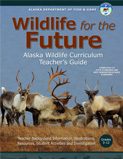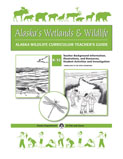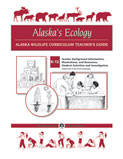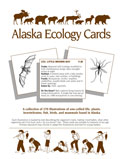Alaska Wildlife Curriculum
The Alaska Wildlife Curriculum is designed for teachers of K-12 students who wish to open their classroom doors and windows to the natural world. Students learn ecological principles that lead to continued conservation of Alaska's wildlife and wild lands.
Each book contains background information and activities for teachers to use as individual lessons or together as units. The activities have been field tested throughout Alaska and are correlated to the Alaska State Content Standards.
Educator Workshops: Workshops are set up for 12+ teachers in communities across the state. To bring a workshop to your community, contact your Regional Wildlife Educator. Workshop costs are minimal and graduate credit is available. Check our workshop calendar or sign up for our list-serv to have information about upcoming workshops delivered to your e-mail.
Sample activity: Oh Moose! (PDF) A fun and active game to learn about limiting factors and carrying capacity of moose.
Wildlife for the Future

Wildlife for the Future (Revised 2016) is geared for middle and early high school students and includes background information and activities covering: biodiversity, population dynamics, wildlife management and research tools, citizen involvement in wildlife conservation, and wildlife-related careers. This 2016 revision is the only volume of the Alaska Wildlife Curriculum that may be fully downloaded. Click here to view and download the curriculum.
Alaska's Wetlands and Wildlife

Alaska's Wetlands and Wildlife (Updated 2017) includes background information and activities covering: wetland ecosystems, food webs, animal and plant adaptations, migration cycles and mapping, effects of climate change on wetlands, outdoor investigations, and wetlands conservation. Activities are correlated to state standards and NGSS. Click here to view and download the curriculum.
Alaska's Forests and Wildlife

Alaska's Forests and Wildlife includes background information and activities covering: tree and forest types, tree structure, the interrelationships between living and non-living elements of forest ecosystems, food webs, the impact of glaciers and fires to forest succession, human impacts on forests, human uses of forests and forest products, and a final unit on forest conservation. The sensory awareness and field observation activity "A Forest Learning Trail" pulls it all together in an outdoor activity that will get all your students involved in studying the forest ecosystem as a whole. Click here to view and download the curriculum.
Alaska's Tundra and Wildlife

Alaska's Tundra and Wildlife includes background information and activities covering: elements of alpine and lowland tundra ecosystems, the role of wind, cold, snow and permafrost, animal and plant survival techniques, tundra food chains and food webs, the fragility and resistance of plants, animals and the land, and conservation issue investigations. Click here to view and download the curriculum.
Alaska's Ecology

Alaska's Ecology (Updated 2018) includes background information and activities covering: the living and non-living elements of ecosystems, food chains, webs and pyramids, interactions within ecosystems, biodiversity and kingdoms, investigation studies, the role of people within ecosystems, renewable and non-renewable resources, and activities leading to conservation in the class and at home. Click here to view and download the curriculum.
Alaska Ecology Cards

Alaska Ecology Cards include 270 sketches of Alaska plants, animals, fish, and invertebrates with life history information on the back. These cards are suitable for coloring, laminating, and copying and may be required for some activities in the Alaska Wildlife Curriculum. Download Alaska Ecology Cards here (PDF 2,881 kB). Plastic versions of these cards are also available.
